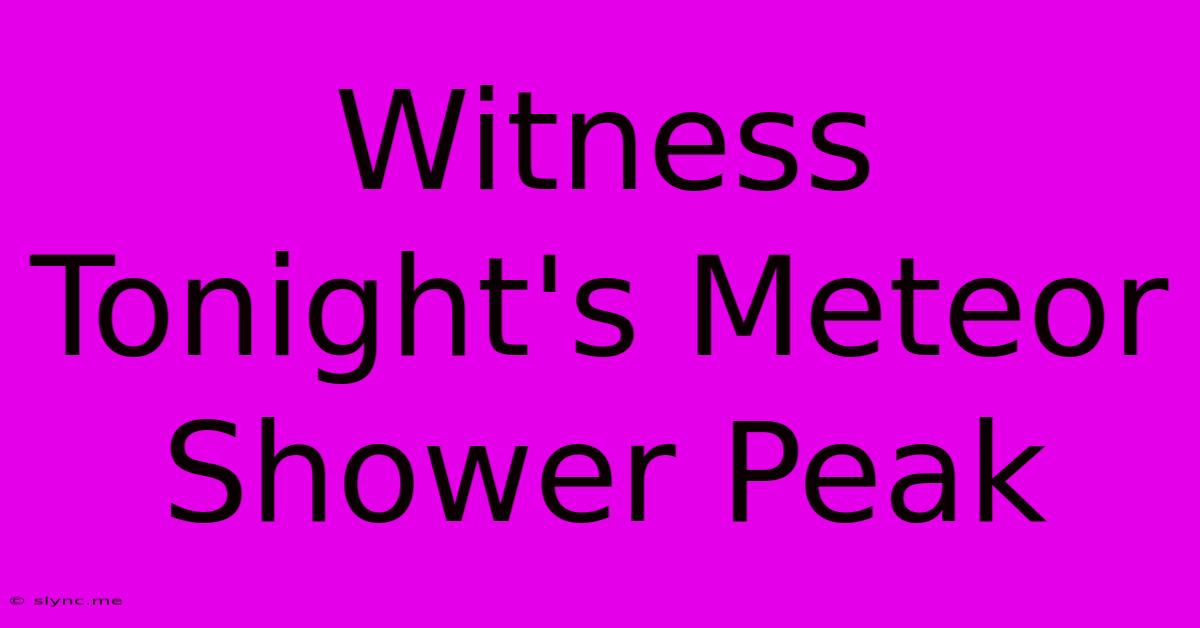Witness Tonight's Meteor Shower Peak

Discover more detailed and exciting information on our website. Click the link below to start your adventure: Visit Best Website Mrs.Amykhan. Don't miss out!
Table of Contents
Witness Tonight's Meteor Shower Peak: A Guide to the Celestial Spectacle
Are you ready for a breathtaking celestial show? Tonight's the night to witness the peak of the [Name of Meteor Shower], promising a dazzling display of shooting stars streaking across the night sky. Whether you're an experienced stargazer or a casual sky-watcher, this guide will help you make the most of this incredible astronomical event.
When and Where to Watch
The [Name of Meteor Shower] will peak on [Date] at approximately [Time] [Time Zone]. However, you can expect good viewing opportunities for several hours before and after this time. To maximize your viewing experience, find a location far away from city lights. Light pollution significantly reduces the visibility of meteors, so head to a rural area, a dark park, or even a high-altitude location for the best view.
Finding a Dark Sky Location: Tips for Success
- Use a light pollution map: Websites and apps like DarkSiteFinder can help you locate areas with minimal light pollution near you.
- Check the weather forecast: Clear skies are essential for meteor shower viewing. Check the forecast before you head out to avoid disappointment.
- Arrive early: Allow yourself plenty of time to find a comfortable spot and let your eyes adjust to the darkness.
What to Expect
The [Name of Meteor Shower] is known for its [describe the meteor shower - e.g., bright and fast meteors, long persistent trains, etc.]. You might see anywhere from [Number] to [Number] meteors per hour at the peak, depending on viewing conditions. Remember that these are just estimates, and the actual number you see might vary.
What are Meteor Showers?
Meteor showers occur when the Earth passes through a stream of debris left behind by a comet or asteroid. These tiny particles burn up in the Earth's atmosphere, creating the bright streaks of light we see as meteors. The radiant point, the area of the sky from which the meteors appear to originate, is located in the constellation [Constellation Name].
Gear Up for the Show
While you don't need any special equipment to enjoy the meteor shower, a few things can enhance your experience:
- A comfortable chair or blanket: You'll likely be spending some time looking up at the sky, so comfort is key.
- Warm clothing: Even during warmer months, nights can get chilly, especially if you're in a dark, open area.
- A red flashlight: Red light preserves your night vision better than white light.
- A star chart or astronomy app: These can help you locate the radiant point and other constellations.
Capture the Moment
Want to capture photos or videos of the meteor shower? Here are a few tips:
- Use a tripod: A tripod is essential for long-exposure photography to avoid blurry images.
- Set a wide aperture and high ISO: This will allow your camera to capture more light.
- Use a remote shutter release: This will prevent camera shake when taking long-exposure shots.
Alternatively, simply enjoy the spectacle with your own eyes! The beauty of the meteor shower is best appreciated without the distraction of technology.
Beyond Tonight: Future Celestial Events
Don't worry if you miss tonight's peak! Keep an eye out for other upcoming celestial events. Several other meteor showers are visible throughout the year, each with its unique characteristics. Check online resources for a calendar of celestial events to plan your next stargazing adventure.
This year's [Name of Meteor Shower] promises a spectacular show. So gather your friends and family, find a dark spot, and prepare to be amazed by the beauty of the night sky. Happy stargazing!

Thank you for visiting our website wich cover about Witness Tonight's Meteor Shower Peak. We hope the information provided has been useful to you. Feel free to contact us if you have any questions or need further assistance. See you next time and dont miss to bookmark.
Also read the following articles
| Article Title | Date |
|---|---|
| Vistavka Portretiv Zagiblikh U Kropivnitskomu | Dec 13, 2024 |
| Manchester Yunayted Viktoriya Plzen 2 1 | Dec 13, 2024 |
| Chelsea 3 1 Victory Fc Astana Game Breakdown | Dec 13, 2024 |
| Europa League Rangers Vs Tottenham Result Update | Dec 13, 2024 |
| Novi Pk Z Epic Games Store | Dec 13, 2024 |
